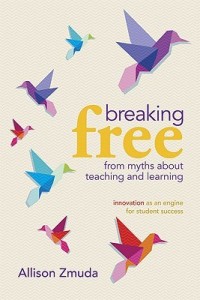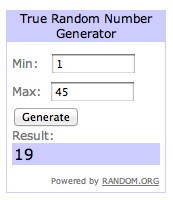
Teaching kids how to cope with mistakes and failure is one of the toughest (and most important) aspects of our jobs as educators. Most of our schools are set up in a way that values a limited number of intelligences, so students who aren’t naturally successful in the traditional areas and core academic subjects often feel frustrated and dumb. The way that schools define failure and success by test scores only compounds the problem. Many children are terrified of taking risks, and view failure as the worst thing that can happen to them. They want to play it safe, fly under the radar, and just get by.
So what do we do about these issues? I’ve invited Allison Zmudato answer some questions on this topic for us. She’s the author of a powerful new book called Breaking Free from Myths About Teaching and Learning: Innovation as an Engine for Student Success. In it, she shares some revolutionary ideas that individual teachers can use to transform the way they educate students despite dysfunctional school systems. Allison clearly understands the stressful situations that teachers face and makes a solid connection between the way we teach and the level of enjoyment we get from it.
One of the things I really love about this book is that after Allison uncovers the root of the problem, she has a section called “Moving to Action.” This section explains not only what schools and school systems can do, but specifically outlines what ONE teacher can do. I find this incredibly empowering, because the implication is that every single educator can affect change. No matter how many problems there are in your school system, YOU can do something to help your students break free from myths about their learning.
I’ve asked Allison to participate in a video chat to answer a few questions with the “one teacher” approach in mind. Her answers below apply to every single one us. No matter how dysfunctional your school or school system is, you CAN make a difference for students, and help them understand and value the journey to success even when they encounter setbacks.
Here are the questions Allison answers in the video above (click here if you can’t see the video):
- What prompted you to write “Breaking Free”?
- One of the myths you talk about is “I feel proud of myself only when I get a good grade.” I’ve seen so many kids who get down on themselves when they get bad grades. What are some practical steps we can take to show kids that we value each level of their progress, and help them understand that improvement is valuable?
- The fourth myth you mention in your book is “If I make a mistake, my job is only to replace it with the right answer.” What can we as teachers do to wean students off their dependency on us to tell them what their mistakes are?
- Many students see failure as the absolute worst thing that can happen to them. You address this with myth #7: “If I get too far behind, I will never catch up.” What can we do to help these students persevere?
- Is there any final thought you want to leave with teachers who are struggling to keep their students motivated and encouraged in a system that is not designed to meet their needs? Anything else we can do to instill courage in kids so they are empowered to take risks as well as experience (and recover from) failure?
Want to win a copy of Allison Zmuda’s book courtesy of ASCD? Leave a comment below with your thoughts on helping kids see failure as part of the learning journey. The contest ends on Thursday, 6/21 at midnight EST.

UPDATED 6/22: Contest closed! The winner is #19, Adam. Thank you to everyone who took the time to leave a comment. I (and obviously many others) enjoyed reading how you grapple with this topic in your own classroom. Wonderful stuff.

Angela Watson
Founder and Writer
Sign up to get new Truth for Teachers articles in your inbox
Discussion
OR

Join our
community
of educators
If you are a teacher who is interested in contributing to the Truth for Teachers website, please click here for more information.
















One of the things that I strive to do in my classes is to create an environment where students understand that mistakes are okay. This is really important with my ELL’s who think that if their English is not perfect they should not speak at all.
I teach in a high socio-economic area. Their parents are a-type and all want their child to be in the top 10% even when little Johnny is born a “b” kid. They have such huge pressure from their families and those parents when little Johnny can’t cut it tend to come after us to “give” it to them. I can’t imagine our administration allowing us to say…”did you learn a lesson, okay lets move on.” I wish they would.
It’s really important for students to see failure as a part of their learning journey, but it’s also important for parents to understand that a failure is not a disaster or a black spot in the grades paper, but a step in their kids learning process. Grades are only that, numbers. And children are more than that.
I tell the parents to remember how they learnt to ride a bike. And I ask them: “Was it perfect the first day? Did your parents tell you nasty words?”. They usually answer: ” No”The fact is that you were encouraged to go on practising to be a good rider, so… why are you so upset for the failure of your kid? He/she needs to practise before being an expert. Will you help him/hem?
I also have this chat with my students, and when they understand it their attitud towards failure changes, and marks start to go up.
They can learn through failure, they learn from their own mistakes or from others mistakes; because, if someone makes a mistake and another student can find it, we are all learning about it, not alone, but with someone on our side.
Sometimes, when I write in the board, I make mistakes in purpose, and students like to find them and they realize that we are not perfect. They say: “Look, even the teacher makes mistakes!”. And they are happy and they feel more secure because they see that the teacher is like them, sometimes I’ve got the right answer, but not always. And it’s not a disaster because we can solve the problem together.
I try to create the feeling that we are a team, and as a team it’s not me that I’m good or bad, but it’s the whole group who is good or bad. And it works.
I think Allison made several great points and I’d love to read her book so I could learn more great tips to help my future students. (I’m still searching for my first teaching job after getting my PreK- 3rd license in May of 2011. I am an educational aide working with an autistic student in the meantime). Thanks, Angela, for sharing another great resource!
WOW! The few minutes I just spent listening and taking notes was more informative and uplifting than some of the hour-ling webinars I have attended lately! I could not write down Allison’s ideas and add my own fast enough. I had a professor in college who must have received similar training because much of what Allison said here took me back to the brainstorming sessions we had in classroom management. Allowing kids to make mistakes is such a fantastic way to take them (and ourselves) out of the testing anxiety we all feel to some degree and just ENJOY learning and discovery. I can’t wait to read this whole book for even more constructive ideas to put into action.